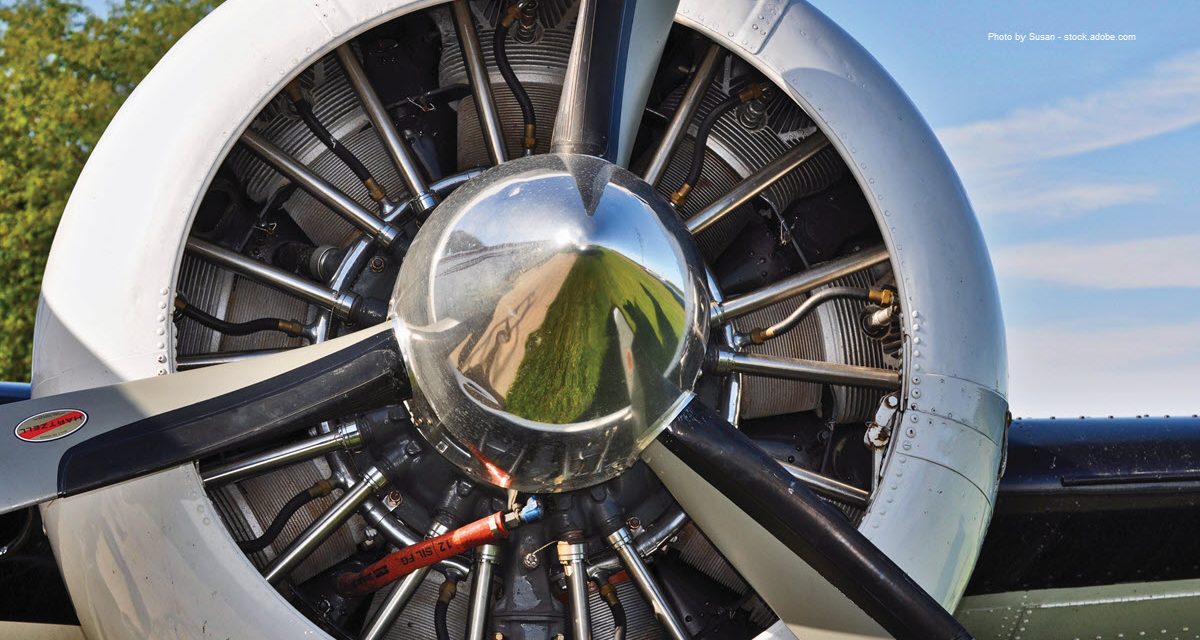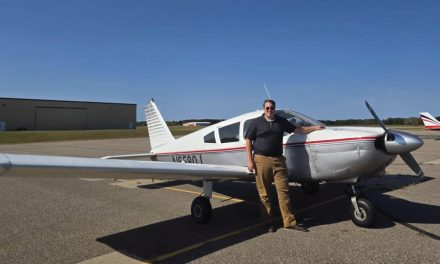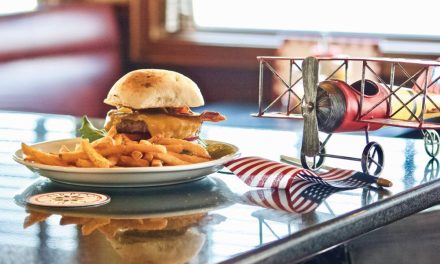By Joel Turpin, ATP/CFII/FAA Master Pilot
I was hired by United Airlines on June 9, 1986. At that time, we operated a mixed fleet of modern, glass panel cockpit airplanes and older, round dial airplanes. Specifically, the B-737 fleet had both types in its livery. At some point, it became fashionable for our pilots to refer to the older airplanes derisively as “rope starts.”
It was common to hear pilots in casual conversation say something like “I’m taking a bid on the rope start 737.” While this kind of talk may be fun, how many of us truly understand the implications of the term “rope start?” For those of you who don’t, a short history lesson is in order.
Up until the early 1950s, lawn mowers were started with a rope. This rope was about three feet long and had a handle attached to one end. A knot was tied in the other end. The mower’s engine had a circular flange bolted to the crankshaft, with a slot cut in it for the rope. The engine was started by slipping the knot into the slot and wrapping the rope around the flange three or four times. The rope was then pulled by the handle and the engine started. Now that was a rope start!
With this in mind, let’s be perfectly honest. There is simply no way you can start a Boeing 737 with a rope. However, all is not lost. A propeller-driven airplane can be started with a rope! I should know. I actually witnessed the rope-starting of an airplane that took place during the early days of my career. Now that I think of it, I might have been more of a participant than a witness. Anyway, I can still remember the incident like it was yesterday…
A Length of Rope
During the Spring of 1977, I was the chief pilot of a small commuter airline. The name of this outfit was Skyway Airlines, now deceased. Our fleet consisted of two modern turboprop Beech 99s, four not-so-modern Beech 18s, four single engine planes of various lineage, and one truly ancient DC-3. The Beech 18s and DC-3 were radial engine, tailwheel types.
Our boss and company president was a veteran aviator from the old days. He had flown the C-46 and C-47 in the Air Transport Command during that little disagreement we had with the Japanese. In fact, he had flown these airplanes over the Himalayan Mountains, aka The Hump, in the China-Burma-India Theater. His name was Audrey.
Audrey operated his little airline from the Forney Army Airfield at Fort Leonard Wood, Missouri. This particular Army base was situated among the streams, the hills, and moonshine stills of the Ozarks. It was the perfect setting for a rope start!
It all began one warm spring day as I was working in my office in flight operations at Forney Field. I received a phone call from one of my Beech 18 captains. He was calling from St. Louis with a complaint about the starter on his left engine. He said it would barely turn the engine over fast enough for a start, adding that it had gotten progressively more sluggish at each stop along his route. I said if he could get it started just one more time, and complete his flight to Fort Leonard Wood, our mechanic would fix it there. He agreed to try.
After rocking the propeller with the bad starter for a minute or so, he finally got the engine running and took off. About an hour later, the captain and his first officer parked their Beech 18 on Skyway’s ramp and discharged their nine passengers. I called our mechanic and the two of us sauntered onto the ramp to greet the crew.
Junior, our line mechanic, climbed into the cockpit and cranked the left engine. We all heard the click of the starter relay, but the prop didn’t budge. The starter was now completely dead. Junior appeared burdened by the situation, saying that it would take several hours to fix. As we stood in front of the Beech 18 discussing the problem, we were joined by Audrey, the company president.
After a lengthy discussion of what should be done, we reached an impasse and lapsed into a thoughtful silence. We would surely have to cancel the remainder of the crew’s schedule which consisted of six more legs. The silence was finally broken when Audrey began to speak. Looking at no one in particular, he commenced in his slow Missouri drawl.
“Well boys, we’ll just get her started, then fly the rest of the day with the engine running.” Looking at the captain, he added “Just don’t shut the left engine down when you board your passengers. We’ll fix the damned starter when you get back tonight.” An uneasy silence followed. After all, getting the engine started was the problem, not the solution!
I couldn’t stand it any longer and posed the question that was surely on everyone’s mind. “Audrey, how are we going to start the engine without a starter?” After a well-planned moment of silence, a wicked little smile appeared on Audrey’s leathery face. Then he spoke, and he had an extraordinary plan.
“We’ll use a rope. Boys, during the war we used to start C-46s and C-47s all the time without the luxury of an electric starter. We’d start ‘em with a rope.”
We were bewildered by Audrey’s plan. None of us could fathom how an airplane could be started with a rope. We would soon find out, and it would be a startling revelation! Audrey did an about face and headed across the ramp toward the fuel truck.
Ernie, our fueler and part time moonshiner, was sitting in his idling fuel truck writing on a clipboard. The boss called out to him. “Ernie! Get the rope from the line shack!” A few minutes later Ernie appeared with a rope that was about 25 feet long and three quarters of an inch in diameter. The boss looked it over thoughtfully, nodding his head in approval, saying it would be perfect for the job.
Audrey then had Ernie move his fuel truck so that it was parked ahead of the left wing, parallel with the leading edge, and facing away from the left engine. He instructed Junior to position the engine maintenance stand in front of the left engine. Then, with rope in hand, Audrey climbed up on the stand and turned to face the engine.
He tied a knot in one end of the rope, slipped the knot behind one of the prop blades, pulled the rope forward, and methodically wrapped the rope around the propeller spinner five or six times. It looked like Audrey was preparing to start a giant, nine-cylinder, 450-horsepower lawn mower!
Next, Audrey tossed the other end of the rope down to Ernie. “Tie that end to the back bumper of the fuel truck and I’ll get into the cockpit. When I’m ready to start the engine, I’ll give you the signal. When I do, drop her down into low gear and take off! Got it?” “Yeah” replied Ernie with trepidation in his voice. Unlike the rest of us, Ernie now had the big picture and his confidence in this operation was beginning to waver. Even so, he climbed into the cab of his truck and patiently awaited the boss’s signal.
Watching all of this filled us younger pilots with a feeling of awe and anticipation. We sensed that we were going to witness an event that is only seen once in an entire career. We were about to see an airplane rope-started!
A Critical Error
Audrey climbed into the left seat of the Beech 18 and opened his sliding window. Since I was the chief pilot, I thought I should at least be involved on the periphery of this operation, just in case something went wrong. With this as justification, I occupied the copilot’s seat. This innocent act unwittingly changed my involvement from casual observer to participant, a role that haunts me to this day.
Audrey then committed a serious procedural error, for he altered the normal engine start sequence. Under more civilized circumstances, we would have cranked the engine with the mixture levers in full rich, counted off “9 blades” passing by the cockpit window, then switched on the magnetos which would have started the engine. Audrey switched the magnetos on before starting the engine. Now, instinctively, I knew this wasn’t right, but having never seen a rope start, I wasn’t sure so I didn’t say anything. I should have, as events would soon prove! Anyway, Audrey shouting made me forget about the magnetos.
“Ernie, pull forward a little and take the slack out of the rope!” The ever-obedient fueler inched his truck forward until the rope was taut. “Stop! That’s perfect,” shouted Audrey. Everything was set for a rope start. But would it actually work? It was a tense moment, and we held our breath.
The tension was broken when Audrey shouted, “Gun it Ernie!” Ernie mashed the accelerator pedal to the floor and the fuel truck lurched forward. We couldn’t believe our eyes when the propeller began to turn. The plan was actually going to work! And after just two revolutions, the big Pratt & Whitney roared to life in a cloud of smoke.
But something was wrong! The engine had started too soon. It was running but there were still three or four rope wraps left on the propeller spinner. Then, Ernie got distracted by the engine and inadvertently steered the fuel truck slightly to the left. This angled the rope into the propeller’s plane of rotation. One of the prop blades hooked the rope causing it to break. A 10-foot section of the rope was still attached to the propeller, which was now spinning at 1000 rpm. The rope began beating the airplane with a vengeance, striking the fuselage just ahead of the cockpit, making a terrible sound. Whap! Whap! Whap!
Audrey was stunned and confused by the noise and took no action. I grabbed the mixture control and yanked it to the fuel cut-off position, an act that erased any doubt about my role as a participant in this ill-fated venture. All nine cylinders of the Pratt & Whitney quit firing and the propeller quickly coasted to a stop. Whap! Whap, whap, thunk, thunk, then silence. It was over.
Feeling more than a little foolish, we climbed out of the cockpit and walked forward to the left engine. The raucous noise had attracted a small crowd of pilots, dispatchers, and bag loaders. Gapers.
A quick survey revealed the painful truth. This airplane would not be going anywhere soon. The fuselage had dozens of deep dents in the aluminum skin. In addition, the propeller anti-ice system, which consisted of an alcohol slinger ring, two spray nozzles, and associated tubing, had been completely mangled by the rope. And finally, the starter still needed to be fixed.
One Small Victory
The great scheme to use ingenuity to overcome adversity lay in ruins. Although we had been defeated by our own hands, there was one thing that could never be denied. We had started an airplane with a rope. We just couldn’t fly around with a 10-foot section of it whacking the hell out of the fuselage!
So, the next time you hear one of the pilots at United refer to an airplane as a “rope start,” remember, it’s no longer just a fun way to describe something old. It can be done. It has been done!
FYI: If any of our pilots mention rope-starting, I’ll deny any knowledge of the subject. “Start an airplane with a rope? You must be crazy!” Sometimes it’s best to let sleeping dogs lie.






